The Burmese python, Python bivittatus, is one of the largest and most well-known snakes in the world. These giant snakes are native to Southeast Asia and get their name from the country of Burma, also known as Myanmar. They have captured people’s imagination due to their beautiful scales, power, and size, but there’s more to these snakes than meets the eye. Here is a list of 10 Burmese pythons facts that explore what makes these snakes so scintillating.

10. Burmese Pythons Can Grow to Enormous Sizes

Burmese pythons can reach an enormous size.
©Irina oxilixo Danilova/Shutterstock.com
This first entry on our list of Burmese python facts is also one of the biggest. Snakes come in a range of sizes, from tiny garden snakes measuring mere inches to giant pythons and anacondas as long as a limousine. Like other members of the family Pythonidae, Burmese pythons enjoy a reputation as one of the largest snakes in the world. Typically, females measure slightly longer but significantly heavier and thicker than males. Even at their smallest, adult specimens rarely measure less than 7 feet, 9 inches long.
The record for the longest Burmese python ever recorded belongs to a female at Serpent Safari reptile zoo in Gurnee, Illinois. This female measured 18 feet, 10 inches long, although unverified reports claim that some specimens in the wild measured up to 23 feet long. Meanwhile, one female known as Baby holds the record for the heaviest snake recorded at a whopping 403 pounds.
9. Some Burmese Pythons Brumate

Burmese pythons brumate during the winter.
©Heiko Kiera/Shutterstock.com
Hibernation is a common trait in numerous animals, including hedgehogs and chipmunks. Animals hibernate by slowing down their metabolism and relying on reserve stores of fat to survive the lean winter months. While hibernation is typically associated with mammals, several fish, reptiles, and amphibians also lie dormant during the winter.
Some Burmese pythons that live in more northern regions brumate during the winter. Like hibernation, brumation is triggered by a lack of heat and shorter daylight hours. Burmese pythons brumate in tree trunks, holes in riverbanks, or under rocks and only rise to drink water. They also prepare their reproductive organs for the breeding season during this period.
8. Burmese Pythons Are Strong Swimmers
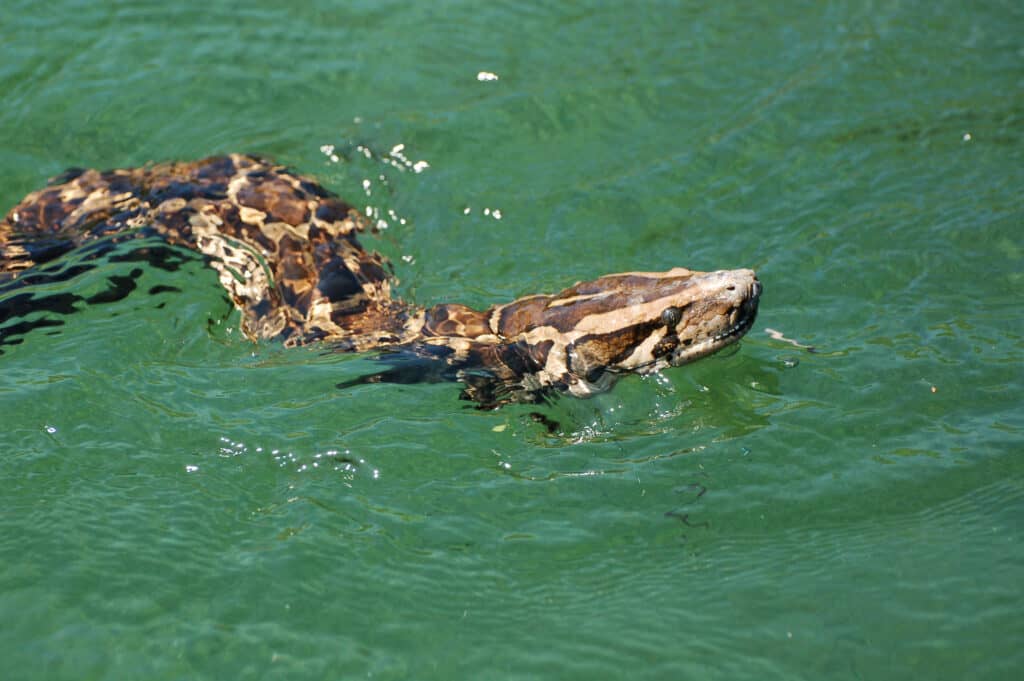
Burmese pythons are strong swimmers.
©Heiko Kiera/Shutterstock.com
When most people imagine snakes moving, they imagine their long bodies gliding over the ground in undulating ripples. Most snakes tend to spend their time on the ground, true, but some species defy these expectations. For example, some snakes spend a large amount of their time in trees, while others “fly” by gliding through the air over short distances.
For their part, Burmese pythons spend a decent amount of time in trees when they are young. As they grow older and heavier, they move to the ground and spend hours hidden under vegetation. However, Burmese pythons also make excellent swimmers. Not only can they swim efficiently, but they can also hold their breath underwater for up to 30 minutes.
7. Adult Burmese Pythons Have Almost No Predators
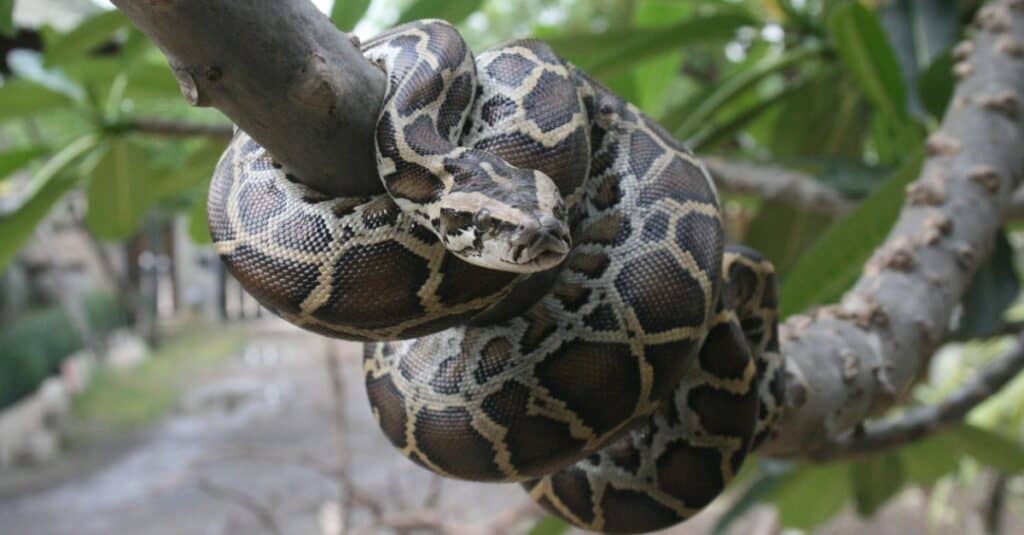
The Burmese python is able to swallow animals as large as a deer.
©iStock.com/Lunatic_67
When young, Burmese pythons face a number of threats. They must contend with predators such as birds of prey, mongooses, and even other snakes. However, as they grow older and larger, fewer and fewer animals can hope to contend with a Burmese python. Their large size and powerful muscles make them practically invulnerable to predation.
Adult Burmese pythons have next to no predators, but that does not mean they are entirely safe in the wild. Humans pose the most significant threats to Burmese pythons as they are caught for their skin and the pet trade. The only other animal that can hope to contend with an adult Burmese python is an adult alligator. Even so, alligators and Burmese pythons will often kill each other, making them practically equals when it comes to the food chain.
6. Burmese Pythons Crush Their Prey to Death
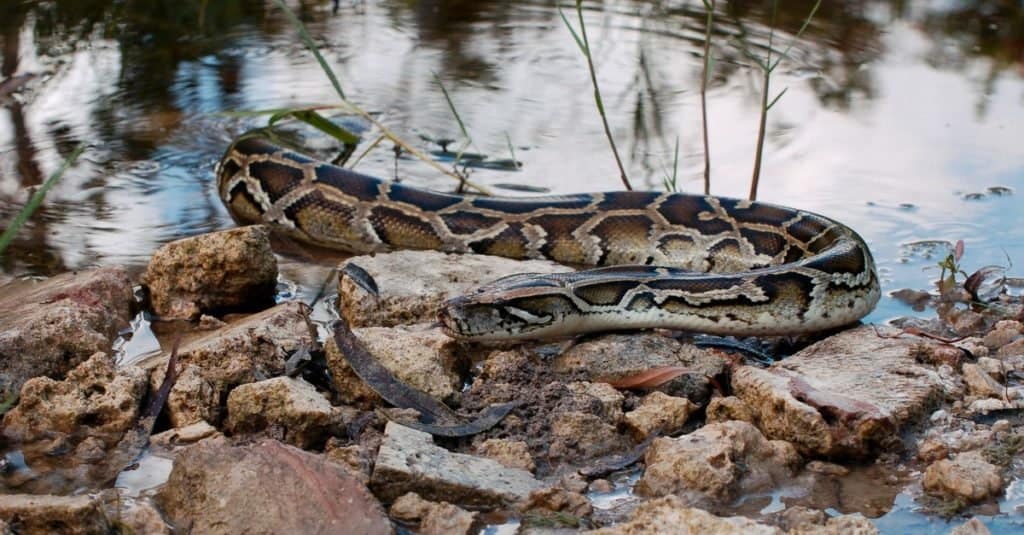
These pythons constrict their prey.
©Heiko Kiera/Shutterstock.com
This next entry is one of the more infamous Burmese python facts. Despite popular perceptions of snakes, the vast majority of snakes aren’t poisonous. In fact, only around 600 of the nearly 3,500 known snake species produce venom. The vast majority of snakes do not kill with venom but instead squeeze their prey to death. These constrictor snakes stop their prey from breathing and cause them to die from shock or suffocation.
Like many other constrictors, Burmese pythons hunt by using ambush tactics. They sit and wait for the prey to wander close and then strike rapidly and wrap up their victim. Adult specimens can exert around 6 pounds per square inch, and given their massive size, they can quickly smother or induce a heart attack in their prey.
5. Burmese Pythons Possess a Powerful Digestive System

The Burmese python frequently kills and digests animals much larger than itself.
©Firman Wahyudin/Shutterstock.com
Once they have killed their prey, Burmese pythons begin the task of consuming their meal. This can turn into an enormous task, as Burmese pythons frequently kill animals more massive than themselves, such as deer and alligators. They swallow their prey whole and have evolved an exceptionally sophisticated digestive system for handling large meals.
Burmese pythons often fast for a long time between meals, going weeks or months without eating. During this time, their stomach volume, acidity, and intestinal mass all shrink. After they ingest prey, Burmese pythons restructure their intestines, produce extra stomach acid, and even increase the mass of their hearts to help produce enough energy for digestion. The digestive process can take anywhere from 8 to 14 days, depending on the size of the meal.
4. Female Burmese Pythons Are Protective Mothers
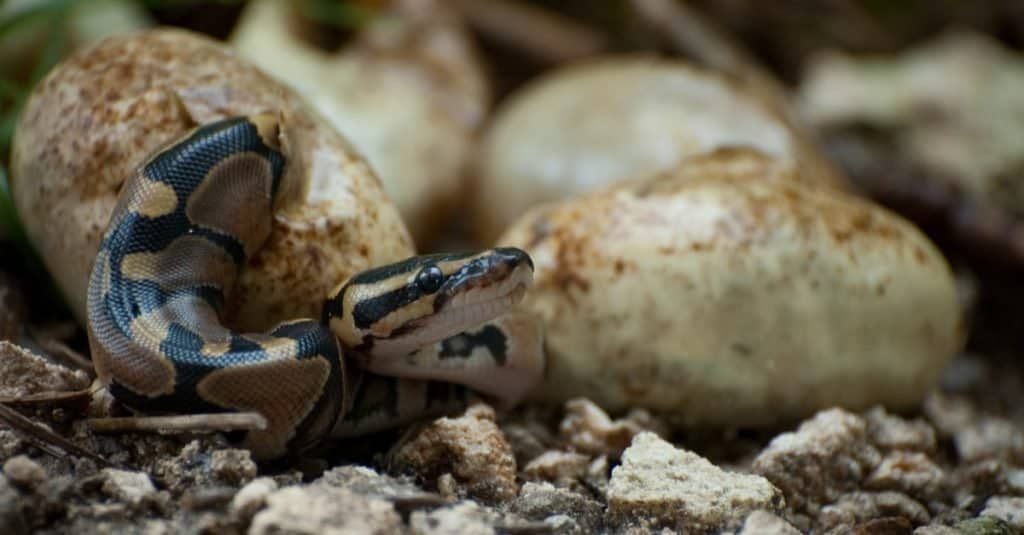
Burmese pythons care for their young.
©Heiko Kiera/Shutterstock.com
This next entry is one of the more surprising Burmese python facts. People often consider snakes cold and indifferent, and these feelings extend to our perception of them as mothers. It’s worth noting that infant snakes can take care of themselves immediately after birth, so motherhood is not necessary from an evolutionary standpoint. At the same time, although it’s true that the majority of snakes don’t explicitly care for their young, this is not true for all species.
Several cobra and python species, including Burmese pythons, care for their young in various ways. Female Burmese pythons will remain with a clutch of eggs until they hatch and protect the eggs from predators. Additionally, females wrap their bodies around the eggs and twitch their muscles to create ambient heat. Once the eggs hatch, mother Burmese pythons leave their young to fend for themselves.
3. Burmese Pythons Make Popular Pets

Burmese pythons are in relatively high demand as exotic pets.
©PaniYani/Shutterstock.com
Over the last several decades, the demand for exotic pets has increased exponentially. This has led to a rise in demand for large snakes such as anacondas and pythons. Due to their large size, fearsome reputation, and beautiful scales, Burmese pythons have become increasingly popular in the pet trade. As a result, tens of thousands of snakes made their way from Southeast Asia and into homes and pet stores around the world.
Before you consider getting a Burmese python to keep as a pet, there are a few things you should consider. First, they are not suitable for beginners due to their size, temperament, and cost. They also live for a relatively long time as they can frequently live up to 20 years in captivity. Finally, if not handled correctly, they can easily kill a human due to their power and size.
2. Some Places Consider Burmese Pythons Invasive

These snakes are highly invasive species.
©asawinimages/Shutterstock.com
Burmese pythons hail from the jungles of Southeast Asia. Within these regions, they face a number of natural predators that keep their numbers low. Due to a rise in demand for Burmese pythons from international buyers, Burmese pythons are now found in many homes worldwide. However, in some places, escaped pythons have managed to carve out territory for themselves in the wild and now threaten local ecosystems.
In Florida, Burmese pythons are considered an invasive species. Many pythons imported to the state during the 1990s and early 2000s were subsequently let loose or escaped into the wild. Today, thousands of pythons live in the wild, particularly in the Everglades in southern Florida. Aside from American alligators, they face few natural predators and have begun to disrupt local wildlife. Despite numerous efforts to curtail their spread, these snakes continue to thrive in the wild.
1. Burmese Pythons Are Considered Vulnerable by the IUCN
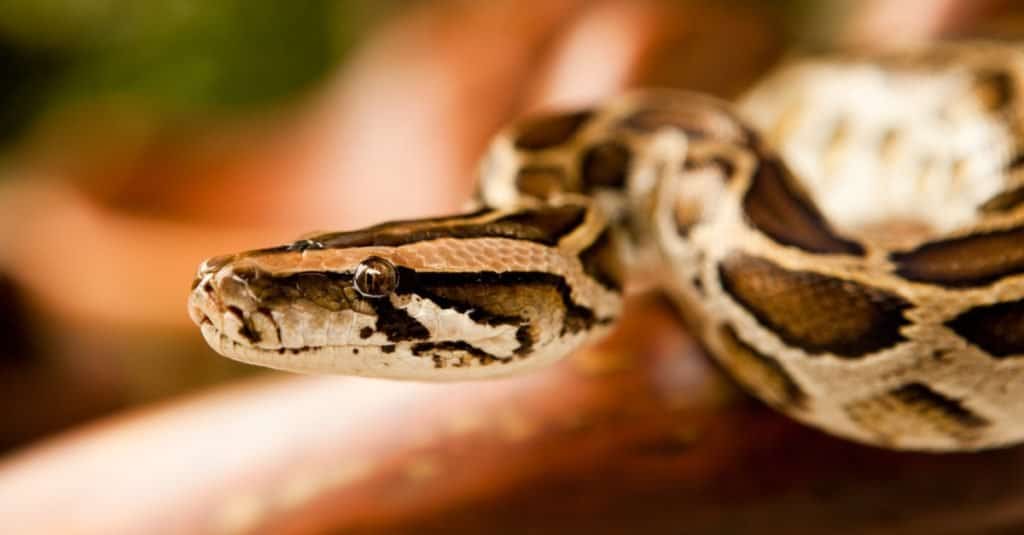
The worldwide population of Burmese pythons has declined by nearly 30%.
©lunadoc/Shutterstock.com
Unfortunately, Burmese pythons are threatened and on the decline. Researchers estimate that Burmese pythons have declined nearly 30% worldwide over the past few decades. The biggest threats come from habitat loss and over-harvesting of the skin and the pet trade. Although a number of countries have instituted policies to protect Burmese pythons, only time will tell if these efforts are successful. In response to the decline in Burmese pythons, the IUCN lists them as a Vulnerable species.
The photo featured at the top of this post is © Heiko Kiera/Shutterstock.com
Discover the "Monster" Snake 5X Bigger than an Anaconda
Every day A-Z Animals sends out some of the most incredible facts in the world from our free newsletter. Want to discover the 10 most beautiful snakes in the world, a "snake island" where you're never more than 3 feet from danger, or a "monster" snake 5X larger than an anaconda? Then sign up right now and you'll start receiving our daily newsletter absolutely free.
Thank you for reading! Have some feedback for us? Contact the AZ Animals editorial team.






